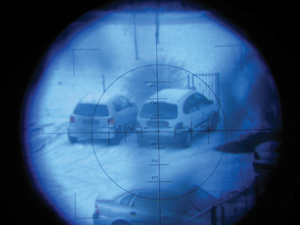
CHAPTER 12
IN THE CROSSHAIRS
WHEN PSYCHOPATHY AND POLITICS MIX, THE RESULT CAN BE TRAGIC AND DEADLY.

Coldblooded assassins most often train their sights on political figures.
THE MAN WHO SHOT LINCOLN
THE STAGE ACTOR JOHN WILKES BOOTH HAD ALWAYS DREAMED OF IMMORTALITY. WITH ONE CALCULATED ACT OF VIOLENCE, HE ACHIEVED IT.
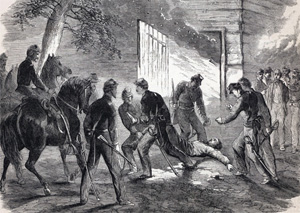
The Killing of Booth, the Assassin. A wood engraving from 1865 shows the dying Booth being dragged from the barn where he had taken refuge.
John Wilkes Booth was born in 1838 near Bel Air, Maryland, into a family of famous stage actors. His father was Junius Brutus Booth, renowned in Great Britain and the U.S., and his brother was Edwin Booth, famous for his portrayal of Hamlet. John joined the family business too, making his stage debut at 17. He toured widely, often playing in Shakespearean productions, and once commented that his favorite role was Brutus, slayer of the tyrannical Julius Caesar.
As the national debate over slavery and secession heated up in the late 1850s, most of the Booth family declared their support for the Union, but John made clear he sympathized with the Confederate cause. He joined the Virginia militia in 1859, but once the Civil War broke out he did not see battle and instead continued his lucrative theatrical career in the North. Eventually, Booth grew depressed at what he referred to as his four-year “idleness,” especially when it became apparent that the South was going to lose the war.
Plot Against the President
For six months in 1864—1865, Booth concocted various schemes to abduct President Abraham Lincoln and carry him off to Richmond, Virginia. On March 17, 1865, Booth and six conspirators went as far as lying in wait to seize Lincoln on the outskirts of Washington, D.C., but the president changed his plans and never appeared. Within weeks, after the Union Army captured Richmond on April 3, Booth concluded that his kidnapping scheme was no longer feasible. He began to formulate plans to assassinate the 16th president instead.
On April 11, Lincoln gave a speech supporting limited suffrage for African Americans. Booth, who was strongly opposed to emancipation, told a friend, “Now, by God, I’ll put him through. This is the last speech he will ever make.” He put into motion his plan to kill Lincoln as well as Vice President Andrew Johnson, Secretary of State William Seward, and possibly Secretary of War Edwin Stanton and General Ulysses Grant.
After learning that Lincoln intended to attend a performance of Our American Cousin at Ford’s Theatre in Washington, D.C., on Friday, April 14, Booth and his conspirators took action. That night, two of Booth’s accomplices, Lewis Thornton Powell and David Herold, worked together to attack Seward and three others at Seward’s house. Another accomplice, George Atzerodt, was assigned to Andrew Johnson, but lost his nerve. The potential assassins of Stanton and Grant, if they existed, have never been uncovered.
Shortly after 10 PM, Booth entered the presidential box in Ford’s Theatre unobserved. Using a .44 caliber Derringer pistol, a small and easily concealed handgun, Booth fired a single shot into Lincoln’s brain at point-blank range before jumping to the stage. Booth shouted, “Sic temper tyrannis!” —“Thus always to tyrants,” the motto of the state of Virginia—then ran down the back stairs to a waiting horse and escaped into the Maryland countryside. Lincoln died at 7:22 AM the next morning. His body was brought to Springfield, Illinois, for burial, as more than seven million somber spectators lined the railroad tracks to view the funeral train. Two weeks later, Union soldiers tracked down and shot Booth, who was hiding out on a Virginia farm.
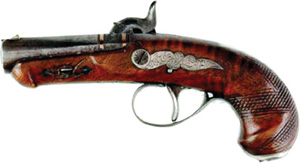
The Derringer pistol used by John Wilkes Booth to assassinate President Abraham Lincoln.
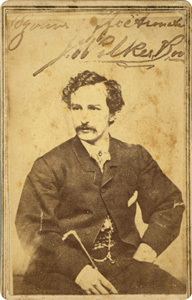
A studio portrait of John Wilkes Booth, circa 1860—1865
THREE THINGS YOU PROBABLY DIDN’T KNOW ABOUT LINCOLN’S ASSASSINATION
• John Wilkes Booth is buried in his family plot in Green Mount Cemetery in Baltimore, Maryland, but his grave remains unmarked at the request of the Booth family.
• Mary Surratt was a widow who kept the Washington, D.C., boardinghouse where John Wilkes Booth hatched the plot to kidnap Lincoln. For her role in the conspiracy, Surratt became the first woman executed by the Federal government.
• Anderson Ruffin Abbott was one of the physicians attending the dying president. He was the first black Canadian licensed as a doctor and was a personal friend of Lincoln’s.
JOHN WILKES BOOTH’S FLIGHT
After leaving Ford’s Theatre, Lincoln’s killer made a daring escape to a farm in Maryland.
In the wake of President Lincoln’s assassination, panic and anguish swept the nation. After a two-week search, John Wilkes Booth was discovered in a barn on a farm near Bowling Green, Virginia, on April 26. The barn was set on fire, and Booth was shot by his pursuers when he refused to surrender. Although his body was identified by numerous witnesses, the myth that Booth escaped has persisted. Booth’s route and the spot where he was felled remain a source of fascination for many Civil War buffs, some of whom enjoy tracing it by car or tour bus.
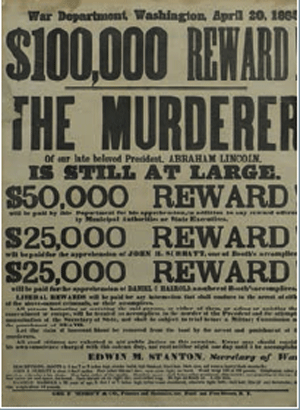
Poster of the hunt for Booth
THE CONSPIRATORS
Assassin John Wilkes Booth relied on the help of many operatives including:
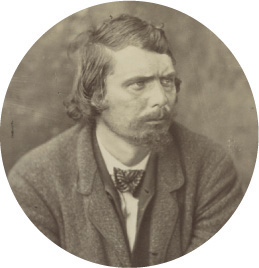
George Atzerodt, carriage repairman assigned by Booth to kill Vice President Andrew Johnson. He failed to follow through.
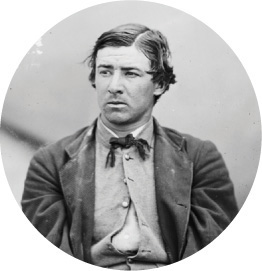
David Herold, pharmacist’s assistant involved in the attack on Secretary of State William Seward. Helped tend Booth’s injuries.
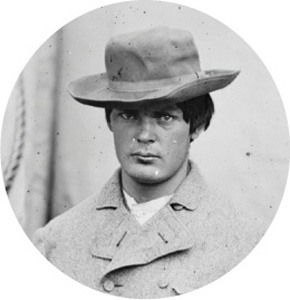
Lewis Payne, Confederate soldier who attacked Secretary Seward.
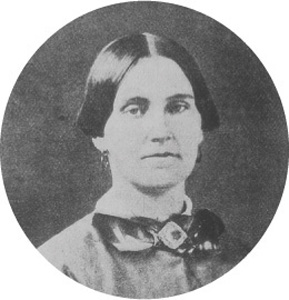
Mary Elizabeth Jenkins Surratt, boardinghouse owner who held guns and supplies for Booth and his accomplices.
PRESIDENTIAL TARGETS
DEATH THREATS AND ASSASSINATION PLOTS ARE A HAZARD OF THE JOB FOR OCCUPANTS OF THE OVAL OFFICE.
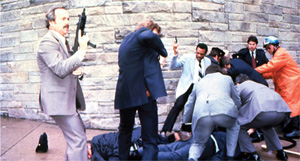
James Brady and a police officer lying on the ground after being shot, while the suspect John Hinckley Jr. is apprehended, moments after the attempted assassination of President Ronald Reagan in 1981.
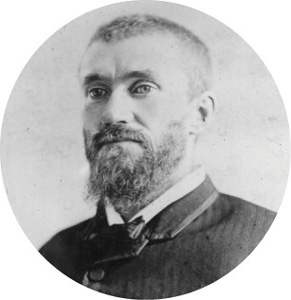
Charles Guiteau, assassin of President James A. Garfield in 1881.
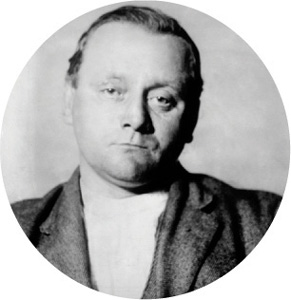
John F. Schrank, who attempted to assassinate Theodore Roosevelt in 1912.
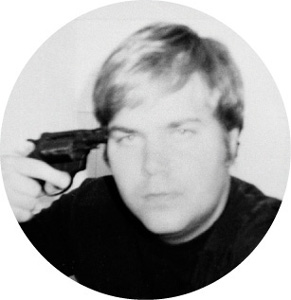
John W. Hinckley Jr., who attempted to assassinate President Ronald Reagan in 1981.
The Leader of the Free World lives dangerously. Since the nation's founding, there have been more than 20 documented assassination plots to kill sitting and former U.S. presidents as well as the president-elect. Mental illness, the desire for notoriety, and political beliefs have all played roles in the planning and execution of the various attacks.
“I Am a Man of Destiny …”
In 1881, just 16 years after President Lincoln’s assassination, lawyer and preacher Charles Guiteau shot President James Garfield in a Washington, D.C., railroad station. Garfield died less than four months after he had been sworn in.
Guiteau displayed obvious mental instability during his two-month trial, constantly insulting his defense team, reciting long poems to the jury, and claiming that his act wasn’t murder at all, but the will of God. “I claim that I am a man of destiny as much as the Savior, or Paul, or Martin Luther, or any of those religious men of the kind I was,” he proclaimed. Guiteau was found guilty and hanged on June 30, 1882.
A Radical Anarchist
Leon Czolgosz, who killed President William McKinley in 1901, was a former steelworker who had lost his job during the economic panic of 1893. He turned to radical anarchy, a philosophy based on the abolition of all government, and fixated on McKinley as a symbol of imperialism. He shot the 25th president twice as McKinley shook hands in a reception line at the World’s Fair in Buffalo, New York. One bullet grazed McKinley; the other entered his abdomen and was never found. In the days between McKinley's death on September 14 and Czolgosz's trial on the 23rd, Czolgosz refused to speak to his lawyers, making it impossible for them to prepare a defense. After only a half hour of deliberation, the jury convicted Czolgosz. He died in the electric chair less than seven weeks after the assassination.
Bulletproof
In 1912, John Schrank, a saloon-keeper from New York, attempted to assassinate former president Theodore Roosevelt, who was seeking to return to the oval office after a few years as a private citizen. Schrank, who stalked Roosevelt for weeks before the incident, approached the candidate after a campaign speech in Milwaukee, pulled out a gun, and fired.
Among his acquaintances, Schrank was known as a fluent Bible scholar and debater, but had not been considered unstable. Eventually Schrank would claim the ghost of William McKinley advised him in a dream to avenge his death by killing Roosevelt. Although he shot Roosevelt directly in the chest, the bullet was slowed by a metal eyeglasses case and the 50-page campaign speech text Roosevelt had tucked into his pocket.
Roosevelt decided he was not dying and held forth for nearly an hour with blood oozing through his shirt.
Schrank was found legally insane and committed to the Central State Mental Hospital in Wisconsin in 1914, where he died in 1943 from natural causes.
Desperate for Attention
John Hinckley Jr., the man who attempted to assassinate President Ronald Reagan in 1981, was obsessed with the 1976 movie Taxi Driver, in which a disturbed character plotted to kill a presidential candidate. He also was infatuated with Jodie Foster, the actor who played a child prostitute in the film.
Hinckley concocted various plots, including an aircraft hijacking and suicide, to impress Foster. Eventually he decided to take Reagan’s life on March 30, after a speaking engagement in Washington, D.C. Four men were shot and wounded in the attack; Reagan was struck by a single bullet, which broke a rib, punctured a lung, and caused serious internal bleeding. He was rushed to a nearby hospital for emergency surgery and hospitalized for two weeks. Hinckley was found not guilty by reason of insanity and remains under institutional psychiatric care.
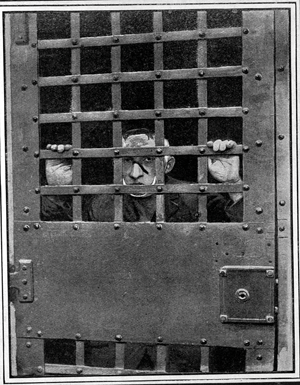
WHO KNEW?
Leon Czolgosz, McKinley's killer, was beaten viciously by a crowd as he was transported to prison. Rioters seemed determined to lynch him.
THE PRESIDENT HAS BEEN SHOT
JFK’S ACCUSED ASSASSIN LEE HARVEY OSWALD TOLD REPORTERS, “I DIDN’T SHOOT ANYBODY … I’M JUST A PATSY!”
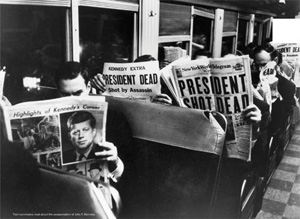
Train commuters read about the assassination of John F. Kennedy.
On November 22, 1963, facing reelection the following year, President John F. Kennedy traveled to Dallas, where he hoped to heal divisions in the Texas Democratic Party. As his motorcade entered the city, he encountered friendly crowds. At about 12:30 PM, the open car carrying Kennedy, his wife, Jacqueline, Texas Governor John Connally and his wife, and several Secret Service agents traveled through Dealey Plaza and passed in front of the Texas School Book Depository.
Suddenly, shots rang out. As bullets ripped through Kennedy’s head and throat, the president slumped forward. Connally, who would eventually recover, was wounded in the back, chest, wrist, and thigh. Half an hour later at Dallas’s Parkland Memorial Hospital, the 35th president of the United States was pronounced dead. Within a short time, Dallas police had arrested Lee Harvey Oswald, a 24-year-old ex-Marine, and accused him of the assassination, as well as the murder of J.D. Tippit, a Dallas police officer who was killed about 45 minutes after Kennedy.
Senseless Shooting or Conspiracy?
But what was the motive? Oswald would never be able to explain. On November 24, as he was being moved from his cell in the basement of Dallas police headquarters, the sniper was shot dead. This time, there was no doubt about the identity of the gunman. Jack Ruby, a nightclub operator with connections to crime figures, committed his crime on live television in front of an audience of millions. Ruby claimed he had been distraught over Kennedy’s death and that he wanted to save Mrs. Kennedy from “the discomfiture of coming back to trial.”
The events unleashed a storm of conspiracy theories that reverberate to this day. An investigating commission headed by Supreme Court Chief Justice Earl Warren was appointed to put the public and world at ease. Almost a year later, the panel, which met primarily in closed sessions, concluded that both Lee Harvey Oswald and Jack Ruby acted alone. Commission members could find no motive for Oswald’s actions.
The Warren Commission report, issued just before the election of 1964, was loudly criticized, with the media and public at large speculating that the investigation was neither thorough nor impartial. In the following decades, hundreds of articles and books claiming to reveal the “real” assassin(s) and motive have been written. Competing theories about the number of shots, the trajectory of the bullets, and the nature of the president’s wounds still attract attention.
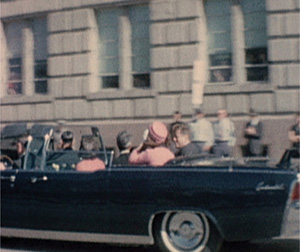
First Lady Jacqueline Kennedy and President John F. Kennedy, before he was shot in Dallas, November 22, 1963.
Secrets and Lies
Polls consistently reveal that more than 60 percent of American adults still do not accept the official account of the Kennedy assassination
Some conspiracy theorists implicate the Mafia, which was angry at U.S. Attorney General Robert F. Kennedy—JFK’s brother—for launching his massive crackdown on organized crime. Still another enduring theory, supported by a number of books written since the assassination, holds that Lyndon B. Johnson, who succeeded President Kennedy, orchestrated the murder plot to ensure his own path to the Oval Office. One of the most persistent theories maintains that the Cuban government was involved, following revelations that the CIA had attempted to murder political leader Fidel Castro.
Finally, several conspiracy theorists point the finger at the CIA itself, which had a strained relationship with the President after the disastrous Bay of Pigs invasion of Cuba. (Agency leaders blamed Kennedy for their failed attempt to overthrow Castro, claiming it was his lack of military support that doomed the commando operation.)
THE LINCOLN–KENNEDY CONNECTION
Similarities between two presidents assassinated in office have become American folklore.
Soon after the Kennedy assassination, a list appeared comparing him to another American president gunned down in office, Abraham Lincoln. Skeptics insist that the correspondences are coincidental—but others find them too compelling to be random.
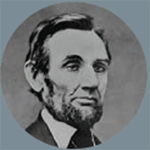
Abraham Lincoln
Elected to Congress in 1846.
Elected president in 1860.
Shot in the back of the head in the presence of his wife.
Shot in the Ford Theatre.
Shot on a Friday.
Assassin, John Wilkes Booth, was known by three names, composed of 15 letters.
Booth was killed before being brought to trial.
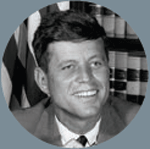
John F. Kennedy
Elected to Congress in 1946.
Elected president in 1960.
Shot in the back of the head in the presence of his wife.
Shot in a Lincoln, made by Ford.
Shot on a Friday.
Assassin, Lee Harvey Oswald, was known by three names, composed of 15 letters.
Oswald was killed before being brought to trial.
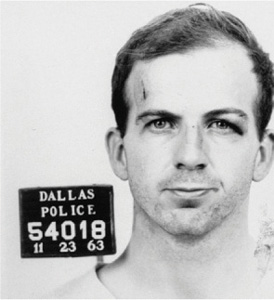
Police mug shot of Lee Harvey Oswald
POWER PLAYER OR PAWN?
Oswald was a Communist with ties to the Soviets and possibly Cuba, raising questions about his motives for killing Kennedy.
After dropping out of high school in 1956, Lee Harvey Oswald joined the U.S. Marines, where he learned marksmanship. But military life did not suit him, and by October 1959 he had become a Communist and moved to the Soviet Union. He was refused Russian citizenship, and in 1962 he returned to the United States with a Russian wife and an infant daughter.
By 1963, Oswald is thought to have been involved with a number of fringe political groups, and may have tried to assassinate right-wing U.S. General Edwin Walker. He is believed to have visited the Soviet and Cuban embassies in Mexico City in an unsuccessful attempt to get a job. In October 1963, Oswald was hired at the Texas School Book Depository in Dallas, where, from the sixth floor, he supposedly fired three shots in five seconds, two of which hit the intended target.
Was Oswald the sole gunman? He denied killing Kennedy and police officer J.D. Tippit, denied owning a rifle, and claimed that photographs of him holding a rifle and a pistol were fakes.
THE BLOODY 1960s
“VIOLENCE IS A PART OF AMERICA’S CULTURE. IT IS AS AMERICAN AS CHERRY PIE.”
—H. Rap Brown, chairman of the Student Nonviolent Coordinating Committee, 1967
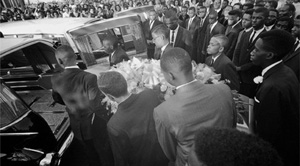
The funeral for victims of the 16th Street Baptist Church bombing.
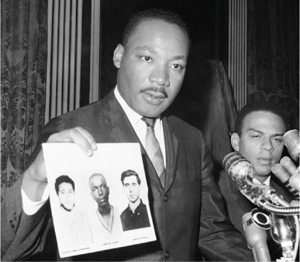
Dr. Martin Luther King displays pictures of three civil rights workers slain in Mississippi, from left, Michael Schwerner, James Chaney, and Andrew Goodman. Dec. 4, 1964.
The assassination of President John F. Kennedy in 1963 ushered in a tumultuous ten years in the United States in which several major political figures and civil rights leaders were killed in cold blood. The killings played out against a backdrop of social upheaval and racial unrest as well as protests against one of the most unpopular wars in the nation’s history. With many of the murders captured live and broadcast to viewers across the nation, Americans experienced the violence in a personal way in their own living rooms.
Much of the era’s violence was racially motivated, executed by Southern whites struggling to maintain the status quo of segregation. But with few witnesses willing to come forward and some evidence in the cases destroyed, prosecutors at the time had difficulty identifying perpetrators and obtaining convictions. When four young girls were killed in the 1963 bombing of a Baptist church in Birmingham, Alabama, only one of four alleged perpetrators was arrested initially. The same year, white supremacist Byron de la Beckwith killed NAACP leader Medgar Evers, but he wasn’t convicted of the crime until 1994. Following the slaying of three civil rights workers in Mississippi in 1964, the government charged 18 people with murder, yet convicted just seven.
In some cases, the murderers were thought to be working alone or with a small group of collaborators. As time passed, however, the public began to suspect that larger organizations were involved. Conspiracy theories have swirled around the murders of both President Kennedy and his brother, U.S. Senator Robert F. Kennedy, who was assassinated in 1968. When the charismatic civil rights leader Malcolm X was gunned down in 1965, one man admitted his role and served time for the killing; another served time but denied guilt. Over the years, theories involving the Nation of Islam and others have circulated, but the Nation has repeatedly denied involvement.
In a similar vein, James Earl Ray, who had a record of armed burglary, theft, and prison escape, quickly pleaded guilty to the 1968 assassination of civil rights leader Dr. Martin Luther King. He later recanted and claimed he was just a pawn in a larger conspiracy. In 1997, King’s family met with Ray in prison and came away convinced that he had been manipulated. His role in King’s murder is still in dispute.
FREEDOM SUMMER
In 1964, the murder of three civil rights workers in Mississippi enraged the nation. Who were they?
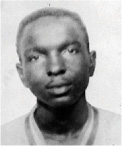
James Chaney: 21-year-old Chaney, an African-American, was born in Mississippi and began his civil rights activism in high school. He participated in a Freedom Ride and voter education.
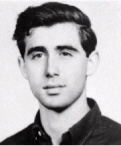
Andrew Goodman: Goodman, 20, was a white New Yorker working to register black voters in Mississippi. He was killed at the end of his first full day volunteering in the state.
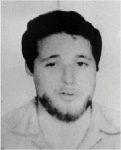
Michael Schwerner: A 24-year-old white New Yorker, Schwerner was a volunteer for the civil rights group the Congress of Racial Equality. He was on assignment in Mississippi with his wife when he was killed.
CONSPIRACY THEORIES
The government obtained convictions for some of the high-profile political murders committed in the 1960s and 1970s, but many people continue to believe a wide range of groups, including law enforcement and the Mafia, were involved.
NAME: John F. Kennedy U.S. President
DATE ATTACKED AND OUTCOME: November 22, 1963. Died that day.
LOCATION: Dallas, Texas
SUPPOSED ASSASSIN: Lee Harvey Oswald. Assassinated by Jack Ruby.
COMMONLY HELD REASON: Unknown
CONSPIRACY THEORY BEHIND IT . . . : CIA, Mafia, Anti-Castro Cuban exile groups, Fidel Castro, J. Edgar Hoover, the Soviet Union, others
NAME: Malcolm X Civil rights leader
DATE ATTACKED AND OUTCOME: February 21, 1965. Killed immediately.
LOCATION: New York City, New York
SUPPOSED ASSASSIN: Thomas Hagan, paroled in 2010; Thomas Johnson, paroled in 1986, died in 2009; Norman Butler, paroled in 1985.
COMMONLY HELD REASON: Break with the Nation of Islam
CONSPIRACY THEORY BEHIND IT . . . : FBI and/or the New York City Police Department
NAME: Martin Luther King Jr. Civil rights leader
DATE ATTACKED AND OUTCOME: April 4, 1968. Died that day.
LOCATION: Memphis, Tennessee
SUPPOSED ASSASSIN: James Earl Ray. Died in prison in 1998.
COMMONLY HELD REASON: Anti-black racism, opposition to civil rights
CONSPIRACY THEORY BEHIND IT . . . : U.S. government, FBI
NAME: Robert Kennedy U.S. Senator from NY. Presidential candidate
DATE ATTACKED AND OUTCOME: June 6, 1968. Died that day.
LOCATION: Los Angeles, California
SUPPOSED ASSASSIN: Sirhan Sirhan. Still in prison.
COMMONLY HELD REASON: Opposed to RFK’s support for Israel
CONSPIRACY THEORY BEHIND IT . . . : CIA
NAME: George Wallace Governor of Alabama. Presidential candidate
DATE ATTACKED AND OUTCOME: May 15, 1972. Paralyzed from the waist down.
LOCATION: Laurel, Maryland
SUPPOSED ASSASSIN: Arthur Bremer. Paroled in 2007.
COMMONLY HELD REASON: Desire for fame
CONSPIRACY THEORY BEHIND IT . . . : Questions have arisen about who funded Bremer’s travel.
IS THIS AN ASSASSIN?
JAMES EARL RAY WAS EITHER A RACIST WHO MURDERED ONE OF AMERICA’S GREATEST CIVIL RIGHTS LEADERS, OR A RACIST WHO DIDN’T.
James Earl Ray on an FBI Wanted poster for the slaying of Dr. Martin Luther King Jr., 1968.
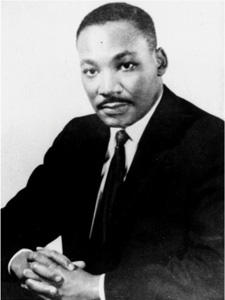
The family of Martin Luther King Jr. asked for a new investigation into his murder after the death of convicted shooter James Earl Ray.
For 30 years, James Earl Ray insisted he was a patsy. He pled guilty in March, 1969, to murdering the Reverend Dr. Martin Luther King Jr. on a balcony in Memphis, Tennessee. By doing so, Ray escaped a trial and the death penalty. But just days later, he recanted, and for the rest of his life, as he served his 99-year prison sentence, Ray would insist that he had been set up by a man he’d known only as Raoul. The military and government intelligence agencies, he maintained, were the puppetmasters.
Ray’s arguments were persuasive enough that in 1978, after a two-year inquiry, a Congressional committee concluded that even though he had fired the fatal shot, there had likely been a conspiracy behind the assassination. And when Ray died in 1998 of complications from hepatitis C, King’s family asked for an investigation of “all new and unexamined evidence.”
It’s hard to know what to believe. Reputable investigative journalists have failed to find plausible evidence that Ray was set up. A comprehensive book published in 1998, entitled Killing the Dream: James Earl Ray and the Assassination of Martin Luther King, Jr., concluded that Ray acted alone.
A Highly Orchestrated Plot?
Whether you believe that Ray was solely responsible for King’s tragic murder or a pawn in a larger plot, certain facts are undisputed. Ray was an avowed racial separatist with a long history of getting in trouble. Born in Illinois in 1928, he was the oldest of eight children in a poor and unstable family. He dropped out of school at age 15 and eventually joined the army, where he was cited for drinking and was discharged for incompetence. In 1949, he moved to Los Angeles and embarked on a career in petty crime, distinguishing himself mostly by his ineptitude and propensity for getting caught. He did several stints in jail—and that’s when it gets complicated.
Ray escaped from the Missouri State Penitentiary in 1967, and ultimately fled to Canada. It was there that he met the mysterious figure called Raoul who Ray later said enlisted him in what he believed was a gun-smuggling venture but turned out to be an elaborate plot to frame Ray for King’s murder.
On April 4, 1968, after months of performing covert errands for Raoul, Ray ended up in Memphis. Under an alias, he checked into a rooming house across the street from the motel where King would be slain later that day. The deadly shot was found to have been fired from Ray’s room, and, using fingerprints from a gun and other evidence abandoned near the scene, the FBI identified Ray as the shooter. After a two-month, $2 million manhunt, Ray was apprehended in London. He was extradited to the United States, where the case was closed—for everyone except Ray.
“I assumed if I did enter a plea of guilty, and I could have had an investigation after the plea, with newly discovered evidence, there’s a possibility that the case could have been reversed,” Ray said in a television interview from prison in 1977. “I think a lot of people have a sort of a Pollyanna view of the legal system …. That’s not the way it is.”
DID HE OR DIDN’T HE?
The conspiracy theories surrounding Ray are based on his behavior and intellect. But so are the theories that Ray acted alone.
RAY WAS A PAWN
Ray was too dumb to have pulled off the assassination by himself.
It seems awfully convenient that Ray left his fingerprint-covered gun for the police to find.
Ray was a nonviolent petty criminal with no real reason to kill King.
VS.
RAY ACTED ALONE
He was clever enough to engineer a complicated prison break from Brushy Mountain.
He had a history of bungling crimes and getting caught.
He was demonstrably racist and pro-segregation.
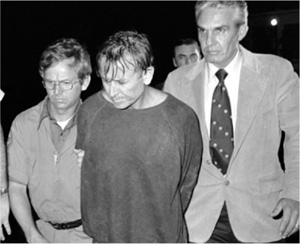
James Earl Ray after his capture, 1977
THE ESCAPE ARTIST
Ray made a lot of mistakes, but he was clever enough to break out of jail not once but twice.
Had James Earl Ray not managed to escape from prison the first time, he might not have been able to assassinate Martin Luther King Jr. in 1968.
In 1967, Ray was several years into a 20-year sentence in the Missouri State Penitentiary for robbing a Kroger store in St. Louis. He had made two failed escape attempts but finally succeeding by stowing away in a large breadbox from the prison bakery that was loaded onto a delivery truck. Ray slipped out as the truck made its rounds.
A decade later, while he was serving time for King’s killing, Ray made his second escape, this time from the Brushy Mountain maximum-security prison in Petros, Tennessee. On June 10, 1977, while some inmates staged a fight to distract the guards, Ray and six other prisoners scrambled up and over a 14-foot wall using a ladder they’d made in the prison machine shop. Guards shot one of the escapees and the FBI eventually captured the rest—including Ray, whom a bloodhound sniffed out three days later, about 8 miles from the prison.
DEADLY TARGET PRACTICE
SOME SNIPERS HONE THEIR SKILLS IN THE MILITARY. THEN THEY TURN ON INNOCENT CIVILIANS AND MENACE THE PUBLIC.
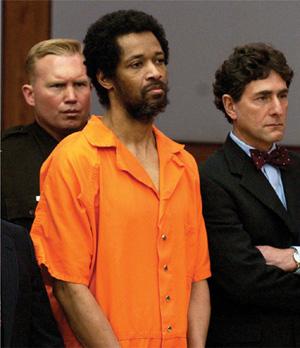
John Allen Muhammad, center, stands with his attorney Jonathan Shapiro (right) as he is sentenced to death.
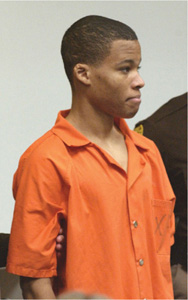
Lee Boyd Malvo stands in court.
Michael Andrew Clark was a seemingly normal 16-year-old living in Long Beach, California. He was known as a good saxophone player, an A student, and “a real fine boy.”
Early on Sunday morning, April 25, 1965, Clark mounted a hill near his home, overlooking Highway 101, with a military rifle equipped with a telescopic sight. Hiding in the tall grass, Clark began firing at cars traveling along the road. He killed three people and wounded ten more before committing suicide as police rushed the hill. No motive was ever established.
It’s the randomness and unpredictability of sniper attacks that make them so terrifying. Snipers’ targets are usually just ordinary strangers going about their daily routines. With a marksman at large, areas that once felt safe become potential danger zones.
The Beltway Sniper
No sharpshooter in recent years has caused more alarm than the so-called Beltway sniper who paralyzed Washington, D.C., and its suburbs for three weeks in October 2002. Ten people were killed and three others critically injured in random attacks on the streets of the capital, Maryland, and Virginia. A landscaper was shot dead while mowing the lawn of an auto dealership; a man was murdered while refueling his car. Others were shot while sitting on a bench waiting for a bus, vacuuming a car at a gas station, walking down the street, and loading shopping bags into a vehicle. The victims were wide-ranging: men as well as women, African American and white, a 72-year-old and a 13-year-old child.
Metropolitan Washington was shadowed by fear. When the killer began planting messages at his crime scenes, the anxiety was magnified. He left tarot cards with chilling imagery, and dropped death threats. One note read, “Your children are not safe, anywhere, at any time.” Parents panicked and schools closed.
Experts presumed the Beltway sniper was a single white male with military experience, but he surprised his profilers. Although it turned out that the sharpshooter had indeed served in the Persian Gulf, he was not white and he was not working alone. He was John Allen Muhammad, an African American, with a teenaged accomplice named Lee Boyd Malvo. The two had met in the Caribbean, and after Muhammad had taught Malvo how to shoot, they had embarked on a robbery-and-killing spree across the U.S. in February 2002.
No real motive for the bloody escapade was ever determined. Investigators suggested that Muhammad had intended to kill his ex-wife, who was keeping him from his children, and that the other murders were meant to camouflage the crime. This theory, however, was never presented in court due to lack of evidence. While he was in jail, Muhammad wrote rambling screeds against the United States, illustrated with images of Osama bin Laden and characters from the film The Matrix. He was executed by lethal injection in 2009. Malvo was convicted of three counts including capital murder and terrorism. He received multiple life sentences without parole.
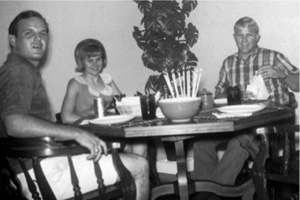
Charles Joseph Whitman, right, with his wife, Kathleen, and a friend just a few months before his killing spree began.
INSIDE CHARLES WHITMAN’S HEAD
The University of Austin sniper had a tumor pressing against a part of the brain that regulates emotions and drives.
Charles Joseph Whitman was a 25-year-old engineering student and former American Marine sniper. On August 1, 1966, he climbed to the 28th-floor observation deck of the University of Texas Tower in Austin with an array of guns, and proceeded to kill 13 people and wound 32 others. Whitman fired almost unimpeded for 96 minutes before he was killed by Austin police.
• A doctor Whitman visited before the shooting reported that Whitman had said something seemed to be happening to him and that he didn’t seem to be himself.
• In his suicide note, Whitman wrote that he had been “a victim of many unusual and irrational thoughts.”
• On the morning of the shooting, Whitman murdered his mother and wife. He left a note reading, “I love [my wife] dearly. I cannot rationally pinpoint any … reason for doing this.”
• During Whitman’s autopsy, doctors discovered a tumor pressing against regions of the brain responsible for regulating emotions and drives, including fighting and fleeing.

According to a report issued by the U.S. Bureau of Alcohol, Tobacco, and Firearms in 2000, the most recent broad government study available, commonly used guns used in U.S. crimes include two different revolvers, a shotgun, and seven semiautomatic weapons. The list is dominated by models that are either available at low cost or have been produced for decades. In 2012, the ATF issued a more general report. Semiautomatic pistols remained by far the most commonly used gun in crimes.
THE TOP 5 GUNS USED IN CRIMES IN 2012
42,560 9mm semiautomatics
34,130 .22 caliber handguns
20,674 .40 caliber handguns
20,606 12-gauge shotguns
19,425 .38 caliber handguns
GUNS SEIZED BY POLICE AT CRIME SCENES
119,273 pistols
46,037 revolvers
Semiautomatics reload automatically, but the trigger must be pulled for each shot. They generate a lot of shots quickly; 16 bullets in 4 seconds and 20 rounds in 5.3 seconds are typical.
THE TEN MOST COMMON GUNS USED IN CRIMES IN 2000
1 Smith & Wesson–style .38 caliber revolver
A Smith & Wesson–style .38 revolver is the most commonly used weapon, in large part because the gun has been produced since 1899 and millions are circulating.
2 Ruger 9mm caliber semiautomatic handgun
In 2000, a new Ruger 9mm semi cost about $500. The gun was made by Connecticutbased Sturm, Ruger & Company, one of the larger producers of handguns in the United States.
3 Lorcin Engineering .380 caliber semiautomatic handgun
Lorcin Engineering, which produced this gun, is now out of business. It specialized in small caliber pistols, many of which retailed for less than $100.
4 Raven Arms .25 caliber semiautomatic handgun
Like Lorcin Engineering, the flrearms manufacturer Raven Arms was known for producing inexpensive handguns. The company went out of business in 1991.
5 Mossberg 12-gauge shotgun
The Mossberg is the most common shotgun used in crimes. Different models of the Mossberg have been on sale since 1961.
6 Smith & Wesson 9mm caliber semiautomatic handgun
Another common 9mm.
7 Smith & Wesson .357 caliber revolver
Like the .38, the larger .357 has been around a long time; the first model was introduced in 1935.
8 Bryco Arms 9mm caliber semiautomatic handgun
Bryco semiautomatics retailed for less than $100 new and around $55 used in 2000. The company was founded by the son of the creator of Raven Arms.
9 Bryco Arms .380 caliber semiautomatic handgun
Bryco Arms was one of the manufacturers of the inexpensive handguns referred to as Saturday Night Specials. The company declared bankruptcy in 2003 and was later sold to another gun maker.
10 Davis Industries .380 caliber semiautomatic handgun
Davis Industries, founded by the son-in-law of the founder of Raven Arms, also specialized in producing Saturday Night Specials.